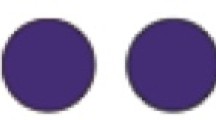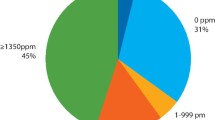Key Points
-
Three quarters of magazine images had teeth that were whiter than the shade guide.
-
Magazines used only a very narrow range of tooth shades compared to real teenaged teeth.
-
The impact of media representation of tooth colour on children's self esteem is unknown.
Abstract
Objectives To compare the colour of incisors depicted in teenage magazines with a sample of Welsh teenagers.
Materials and methods A representative one month sample of magazines aimed at 9- to 16-year-old girls was obtained from a retail outlet. All images containing photographs of anterior teeth were identified and the colour of the incisor teeth measured using two commercial shade guides. An additional category of 'whiter than shade guide' was introduced. Images were viewed under standardised conditions by the same examiner; 10% were repeated. Clinical measurements under standard conditions were taken, by the same examiner, of 9- to 16-year-old children presenting to the department over a one month period, using the same shade guides; 47% of readings were repeated. Data were entered into SPSS and comparison of proportions used to compare the two groups.
Results Nineteen magazines containing 268 images and 53 patients were used. Intra-examiner agreement with the two shade guides was 80% or 92% for patients and 93% or 96% for images. 0/53 (0%) clinical compared with 202/268 (75.4%) photographs were found to be whiter than the shade guide.
Conclusions Teenage magazines do not give an accurate representation of the colour of teenager's teeth. The impact of this on children's self esteem is unknown.
Similar content being viewed by others
Introduction
Children are influenced by popular media and teenaged girls place increasing importance on appearance.1,2,3 Magazines that contain idealised images of body form can result in some readers developing feelings of inadequacy in relation to their appearance.3,4 A randomised control trial (RCT) where girls in grades 7 (age 12) and 10 (age 15) viewed either idealised females (experimental) or fashion accessories (control) found a significant decrease in body state satisfaction and a significant increase in state depression attributable to viewing the female images in both age groups.5
Facial attractiveness is one aspect of body image and increasingly patients demand a perfect smile.6 Around three quarters of orthodontic requests are for aesthetic reasons.7 A recent study comparing malocclusions in teenaged magazines with the adolescent population in the UK found only 7% of magazine smiles exhibited a definite need for treatment on aesthetic grounds compared with a third of the UK adolescent population.8
Tooth colour is one aspect of facial appearance and an increasingly important one, given the rise of both professionally-and consumer-applied tooth whitening products.6 Around a third of adults in the USA are unhappy with the colour of their teeth9 and the 'ideal' smile in popular culture has white straight teeth. This so-called 'Hollywood smile' is becoming more common amongst British celebrities.10 It is perhaps not surprising that anecdotally, requests for bleaching of teeth are increasing amongst children and adolescents as well as adults.
The aim of this study was to determine if the tooth colour of models in magazines aimed at 9- to 16-year-old girls reflected the actual tooth colour of similarly-aged females attending Cardiff Dental School for routine treatment.
Materials and methods
Magazines aimed at 9- to 16-year-old girls were collected for a month from a retail outlet. All colour photographs showing both central incisors with at least 5 mm crown visible were selected. Colour was assessed under standardised conditions by a single examiner using two commercial shade guides, VITAPAN® classical (VITA Zahnfabrik, Bad Säckingen, Germany) and COSMO HXL (Detrey, USA). An additional shade of 'whiter than shade guide' was also used, giving 18 possible shades for each. Ten percent of readings were repeated.
Girls aged 9 to 16 years attending the School of Dentistry for routine treatment over a one month period had the shade of their maxillary incisors measured under standardised conditions by a single examiner using the same two shade guides. Because of the smaller number of patients, 47% of readings were repeated to test reliability.
Data were entered into SPSS and comparison of proportions used to compare the groups. It was not possible to use kappa as a measure of agreement since the data were highly unbalanced among the categories for shade. Kappa is unreliable when used with such data, therefore intra-examiner agreement was assessed by percentage agreement for shade.11
Results
Over the chosen month, 19 magazines containing 571 facial images were obtained. Overall, 303 images were excluded (either too small for assessment, central incisors not visible or black and white images) leaving 268 (47%) suitable images for the study. A total of 53 patients were examined. Intra-examiner agreement for the magazine images (27 of 268) was 93% for VITAPAN® classical and 96% for COSMO HXL. For the clinical readings (25 of 53), agreement was 80% and 92% for VITAPAN® classical and COSMO HXL respectively.
Figures 1 and 2 show the comparison of the shades obtained from the clinical and magazines samples for both shade guides. Over three quarters of magazine photographs were 'off the shade guides' (75% VITAPAN® classical, 80% COSMO HXL). In contrast, for patients all teeth were evaluated as being on the shade guides, with A1 being the most frequently observed shade on both guides (34% VITAPAN® classical, 40% COSMO HXL). Among natural teeth a wider range of shades were seen, with 10 and 11 different shades for VITAPAN® classical and COSMO HXL respectively compared to only five and four shades, including 'off the guide', for photographs.
Tables 1 and 2 show the difference in proportions of teeth falling into each shade category for magazine images and natural teeth for both shade guides. This shows that several shades were not seen for either natural or photographic teeth. The tables also show a clinical and statistically significant difference for VITAPAN® classical on 'off scale', A1, A3, B2, C2, D2 and D3 and for COSMO HXL on 'off scale', A1, A2, A3, B1, B2, C1, C2, C3, D2 and D3, all at the 95% confidence interval.
Discussion
This research used two commercial shade guides to determine tooth colour, as these are widely used by dentists in clinical practice.6 A single examiner reviewed all images and subjects; her intra-examiner reliability was excellent for magazine images, and very good for natural teeth. This difference is because the magazine image has a consistent colour while the tooth shows much more variation, as light follows a highly irregular path through the tooth, some being reflected by the tooth, some being absorbed and scattered within the tooth and some being transmitted through the tooth before emerging at the tooth surface to reach the eye.12
The tooth colour in this sample of magazines does not reflect the colour of British children's teeth. In over 75% of cases the tooth colour was found to be whiter than the shade guides, whereas all the subjects were found to have teeth within the ranges on the shade guides. The matt white tooth seen in the typical magazine does not appear to exist in our sample of Welsh adolescents. While it can be achieved by bleaching or placing porcelain veneers on teeth, it is perhaps most likely that the tooth colour in magazines is the result of manipulation during publishing. In other words, the idealised smile portrayed in these magazines and other media cannot be achieved without some form of cosmetic treatment to the teeth or alteration of the digital image.
The difficulty is determining which has occurred. While digital manipulation of images is perhaps the most likely explanation, it is not the only possibility. The useable images included celebrities, models and others who could have been models or 'readers'. It is possible that models or those already in the public eye chose to have cosmetic dental procedures, such as veneers or bleaching, to enhance their appearance; or indeed that magazine editors are more likely to select images of individuals with 'whiter' teeth. Whichever explanation is correct, the result is the same: the impression in these publications is that exceptionally white teeth are the norm.
It has been shown that some teenage girls can be affected by constant media portrayal of an ideal body shape that cannot be attained by the majority of the population. Eating disorders such as obesity, anorexia and bulimia can occur when body image perception and perception of the desired ideal differ.2,3 A Finnish dental aesthetics attitudes survey found that the appearance of teeth was more important to women and significantly more important to younger people.13 How constant exposure to images of perfect white teeth affects children is unknown. While it could increase their interest in teeth and perhaps oral health, it might also lead to feelings of inadequacy.
Conclusion
The pursuit of the perfect pearly white smile has already created a $500 million (£290 million) industry in the United States and is starting to gain ground in the UK. It is important that in the quest for the perfect smile, overall oral health is not forgotten. Further research is needed to explore the impact of media images in teenagers.
References
McLeod J M . Media and civic socialisation of youth. J Adolesc Health 2000; 27: 341–347.
Borzekowski D L, Robinson T H, Killen T D . Does the camera add 10 pounds? Media use, perceived importance of appearance and weight concerns among teenaged girls. J Adolesc Health 2000; 26: 36–41.
Borzekowski D L, Bayer A M . Body image and media use among adolescents. Adolesc Med Clin 2005; 16: 289–313.
King N, Touyez S, Charles M . The effect of body dissatisfaction on women's perception of female celebreties. Int J Eat Disord 2000; 27: 341–347.
Durkin S J, Paxton S J . Predictors of vulnerability to reduce body image satisfaction and psychological wellbeing in response to exposure to idealized female media images in adolescent girls. J Psychosom Res 2002; 53: 995–1005.
Joiner A . Tooth colour: a review of the literature. J Dent 2004; 32: 3–12.
Birkeland K, Boe O E, Wisth P J . Orthodontic concern among 11-year old children and their parents compared with orthodontic treatment need by index of orthodontic treatment need. Am J Orthod Dentofacial Orthop 1996; 110: 197–205.
Mattick C R, Gordon P H, Gillgrass T J . Smile aesthetics and malocclusion in UK teenage magazines assessed using the index of orthodontic treatment need (IOTN). J Orthodont 2004; 31: 17–19.
Odioso L L, Gibb R D, Gerlach R W . Impact of demographic, behavioural and dental care utilization parameters on tooth color and personal satisfaction. Compend Contin Educ Dent 2000; 21 (Suppl 29): S35–S41.
Fields J . Tooth and sale. The Sunday Herald (Glasgow) 2006 February 19.
Newcombe R G . Two-sided confidence intervals for the single proportion: comparison of seven methods. Stat Med 1998, 17: 873–890.
Van der Burgt T P, Ten Bosch J J, Borsboom P C F, Kortsmit W J P M . A comparison of new and conventional methods for quantification of tooth color. J Prosthet Dent 2002; 63: 155–162.
Vallittu P K, Vallittu A S J, Lassila V P . Dental aesthetics – a survey of attitudes in different groups of patients. J Dent 1996; 24: 335–338.
Author information
Authors and Affiliations
Corresponding author
Rights and permissions
About this article
Cite this article
Chadwick, B., Cage, B. & Playle, R. Do teenage magazines give a genuine view of tooth colour?. Br Dent J 203, E9 (2007). https://doi.org/10.1038/bdj.2007.680
Accepted:
Published:
Issue Date:
DOI: https://doi.org/10.1038/bdj.2007.680
This article is cited by
-
Professional education on oral cancer
British Dental Journal (2007)
-
Tooth colour in teenage magazines
British Dental Journal (2007)





